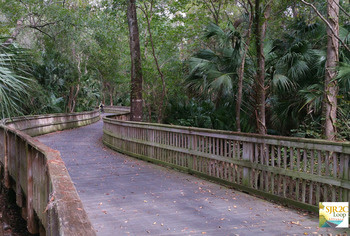Spring 2018

Dunedin officials unveil one of their new trail town signs.
The Florida Department of Environmental Protection (DEP) joined the city of Dunedin and local officials April 19, 2018, to celebrate the designation of Dunedin as the first Florida Trail Town. About 60 people attended while a steady stream of Pinellas Trail users passed in the background.
Starting in the 1980s, Dunedin embarked on a six-fold strategy to transform their town:
- Embrace the Pinellas Trail
- Foster adaptive reuse
- Slow traffic – pedestrian is #1
- Beautify, beautify, beautify!
- Build a sense of place
- Do small projects every year
As a result, Dunedin’s downtown business occupancy rate rose from 30 percent to 100 percent since the Pinellas Trail was built through the town. Bike shops, cafes, motels and other businesses cater to trail users.
“We couldn’t be prouder,” said Dunedin Mayor Julie Ward Bujalski. “Our downtown has thrived around the trail and attracted folks from all ages and abilities. We like to think of the trail as the main artery of our community.”
Florida State Parks Director Eric Draper represented DEP at the event. Governor Rick Scott could not attend, but said in a statement, “In Florida, we are incredibly proud of our state’s beautiful environment and DEP works relentlessly to keep Florida’s outdoor spaces and trails pristine for the millions of families and visitors that enjoy them each year. I want to congratulate the city of Dunedin on being named the first Florida Trail Town. Trails not only provide outstanding opportunities for recreation, but they also help boost the local economy, generating nearly $60 billion each year and supporting nearly 500,000 jobs.”
To recognize Florida’s Trail Towns, DEP’s Office of Greenways and Trails (OGT) encourages interested communities to conduct self-assessments to gauge their strengths and weaknesses in relation to nearby trails and users. Trail Town candidates are then considered for approval by the legislatively established Florida Greenways and Trails Council. Designated Trail Towns are featured on the Office of Greenways and Trails website and given metal signs that can be placed at trailheads and town gateways. Businesses are also given trail town stickers.

By Maggie Ardito, President, St Johns River-to-Sea Loop Alliance
Did you know the Florida Coast-to-Coast Trail (C2C) has a sister? Two years ago the Florida Greenways and Trails Council designated the St Johns River-to-Sea Loop (SJR2C) a top-priority for Florida SUNTrail funding behind the C2C. Both trails start at Titusville and proceed northwest to DeBary, where the SJR2C continues north to Palatka, then heads east to St Augustine before turning south to close the loop at Titusville. As the second sibling, the loop has had to fight for attention. While not as famous as her more sophisticated and urban older sibling, she is not shy about flaunting her natural beauty and country charm. Slightly longer than the Coast to Coast at over 265 miles, the loop boasts more springs, state parks, historic sites, scenic beauty, beaches and farm experiences.
The loop has another advantage – a dedicated nonprofit. The SJR2C Loop Alliance was formed in 2016 to advance, advocate, promote, and protect the loop. In August 2017, the alliance was awarded a grant to develop SJR2C maps. Last fall we held a three-day summit and we’re already planning the 2018 summit. We established the Tri-County Agritourism Corridor, a rural farming belt where tourists can visit local businesses, museums and attend annual events. We work closely with transportation planning organizations, the Florida Department of Transportation, and the five counties along the loop to help close the remaining gaps and celebrate closings. We work with towns around the loop to achieve OGT’s Trail Town designation.
Putting the St. Johns loop on the map is key. New maps will benefit tour guides and marketing material. We partner with Florida’s Scenic Byways program to identify nearby destinations. We highlight trailheads like DeBary Hall, a magnificent 19th century hunting estate that will become the hub of a historic and natural corridor, drawing people into less-traveled Florida.
We envision a time when cyclists fly to Orlando and take a trail or the Sun Rail to the loop for extended tours – as millions of us fly into Amsterdam today. Cycle-tourists are generally low-impact, environmentally-conscious, quiet, slow-moving, and eager to discover less-visited places.
Help put the loop on the map. We’re always seeking volunteers and are interested in reaching out to other trail-groups to share experiences.

Photo of Braden River by Posie Haeger
A paddler’s recent encounter with an otter on the Braden River in Southwest Florida is a good reminder to always practice safety when enjoying Florida’s natural resources. While paddling, remember:
- Be sure everyone in a vessel is wearing a personal flotation device and has easy access to a whistle.
- If you see wildlife, it is OK to take pictures and watch them, but always keep your distance from wild animals.
- Paddle with a buddy, or make sure someone knows where you are and when you will be embarking and returning from your paddle.
- Carry a manual bilge pump for emptying water in a kayak or canoe.
- Know where you are – intimate knowledge of the water body and surrounding terrain makes it easier to assess exit and rescue strategies.
| 




No comments:
Post a Comment